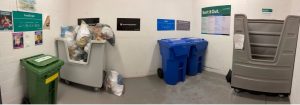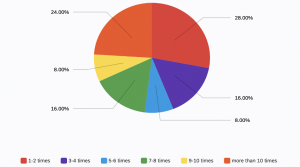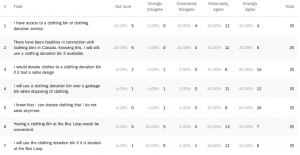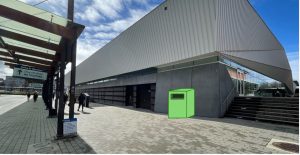Download: Final Report Document – Recommendation of Placing a Clothing Donation Bin at the UBC Bus Loop
Letter of Transmission
2022 Memory Street
Vancouver, BC V2J 3C0
March 26, 2022
AMS Council
AMS Student Nest
6133 University Blvd.
Vancouver, BC V6T 1Z1
Dear AMS Council,
Here is my report, Recommendation of Placing a Clothing Donation Bin at the UBC Bus Loop. Thank you for providing the opportunity and permission to research and observe the current implementation of clothing donation bins and clothing donation services at the University of British Columbia’s Vancouver Campus.
The goal of this report is to introduce the recommendation of placing clothing donation bins at the UBC campus. Many students attend UBC, and it will be beneficial to both students and the environment if clothing donation services are available. The placement of the clothing donation bin will result in less textile waste and increase UBC’s sustainable commitments. This report describes clothing donation, and the clothing donation services at the UBC Vancouver Campus. Finally, I provide a conclusion based on the primary and secondary data gathered from the 30 surveys and online resources.
I appreciate your time and consideration. Thank you for your approval of this project, I look forward to hearing your thoughts on this recommendation If you have any questions about this project or any other concerns, please contact me at 619-224-1234 or email me at fei08@student.ubc.ca.
Sincerely,
Lucy Li
Recommendation of Placing a Clothing Donation Bin at the UBC Bus Loop
for
AMS council
AMS Student Nest
University of British Columbia
by
Lucy Li
ENGL 301 Student
March 26, 2022
Table of Contents
- Background. 1
- Statement of Problem.. 1
- Purpose of this report 1
- Methods of Research. 2
- Scope of the report 2
- Clothing donation bin or donation services at UBC.. 3
- Residences. 3
- AMS Student Nest 4
- Survey from UBC staff and students. 4
- Clothing Purchase Habit 4
- Use of clothing bin or clothing banks. 5
- Thoughts if a clothing donation bin is available. 6
- Benefits of having a clothing donation bin. 7
- Costs, Safety Measures and Managing. 7
Figures
Figure 1:Sorting area at Ponderosa. 5
Figure 2: Survey – Q1 How often do you purchase clothing per year?. 7
Figure 4: Survey Matrix Table– Do you agree or disagree with each of the following?. 8
Figure 5: Mock-up clothing donation bin at Bus loop drop-off and UBC Aquatic Centre. 11
Abstract
The recommendation report of placing a clothing donation bin at the UBC bus loop is based on the current UBC environmental awareness and implementations of clothing donation services.
Clothing donation bins can improve the sustainability impact of the UBC’s students and staff and reduce the negative environmental impact of textile waste in landfills. This report discusses the survey results from 30 UBC students and staff and presents findings from online resources related to clothing donation.
The report summarizes the findings and recommends feasible recommendations for placing a clothing donation bin. The report has the following recommendations:
- Placing a clothing donation bin right next to the Aquatic centre at the UBC bus loop
- Increasing the students’ and staff’s awareness of the clothing donation bins
- Starting with the placement of one clothing donation bin before the decision of placing more
I. INTRODUCTION
A. Background
Clothing donation bins are the big containers in public and private areas where individuals can donate their clothing. These clothing donation bins help recycle clothing that many people do not use anymore to donate to people in need and raise funds for programs, charities, and the food bank. Every season, many individuals would purchase new clothing to add to their closet, and at the same time, many pieces of well-kept garments would be disposed of and end up in landfills. With over 50,000 students attending UBC, it is essential to decrease the amount of clothing going into landfills and increase positive impacts on the environment and the community.
B. Statement of Problem
Many students in UBC do not know about clothing recycling, which causes them to dispose of their clothing in garbage bins. The students living on-campus and off-campus have limited access to clothing donation bins, and even if they know of the donation bin’s existence, many of them are in a distanced location. Considering the long commute time and the location of the nearest donation bins, it discourages the student from travelling to a specific location to donate clothes, which results in disposing of them at the nearest garbage bin.
C. Purpose of this report
This report presents an analysis of primary data that demonstrates student and staff at UBC support the positive impacts of placing a donation clothing bin on campus. Easy access to a clothing bin will contribute to reducing textile waste and increase UBC’s sustainability commitments.
D. Methods of Research
Thirty students and staff at UBC responded to a survey designed to obtain opinions on clothing donation and the use of clothing donation bins. An analysis of the survey results determines the feasibility of the recommendation of placing the donation bins. In addition, findings from online resources are related to clothing donation bins and the university’s involvement.
E. Scope of the report
To assess the feasibility of placing a clothing donation bin at the bus loop, the paper will address the following:
- What do students do with their unwanted clothing?
- What locations in UBC collect clothing or accept clothing donations?
- What are the costs and safety measures of the donation bins?
- How to maintain the organization and collection of clothing from the bins?
- How do students feel about using clothing donation bins?
II. DATA SECTION
A. Clothing donation bin or donation services at UBC
UBC has put in many efforts through recycling stations and other events contributing towards zero waste by waste diversion (“Zero Waste Action Plan”). The efforts include the sort-it-out stations in multiple locations on campus and different events and groups contributing to a more sustainable lifestyle.
1. Residences
According to the UBC student residence website, every residence has a sorting area with bins for food scraps, recyclables, cardboards, garbage, electronic waste, and charitable donations (“Services & Amenities”). The students living in residence have access to the sorting area and can identify which bin the different types of waste belongs to.

Figure 1:Sorting area at Ponderosa
However, these sorting areas do not have all the bins stated on the website and do not have a bin that accepts clothing. These bins and labels leave students to dispose of their clothing as garbage since the other bins do not accept clothing.
2. AMS Student Nest
The UBC Free Store located in Room 2102 in the AMS Student Nest focuses on environmental awareness through circulating products, clothing, and consumer good within the UBC (“UBC Free Store”). Individuals from UBC take what they need costs free and donate what they do not need for others. However, not everyone knows of this store since its marketing still needs improvement compared to the other stores or services in the Nest.
B. Survey from UBC staff and students
A survey consisting of nine multiple choice questions was designed and sent to UBC students and staff to obtain their opinions on clothing donation bins and their clothing purchase habits. The results from the completed surveys are voluntary and anonymous without questions that identifies the participant.
1. Clothing Purchase Habit
There are over 50 000 students enrolled at the Vancouver UBC campus, of which 11 000 students of them live in UBC housing (University of British Columbia, 2021). It is natural for such a large population to purchase many multiple clothing articles throughout their lifetime and dispose of them when not in need.
As shown in Figure 2, 28% of the participants purchase clothing over ten times a year, while 24% only purchase once or twice. The trend shows two main types of clothing purchase habits amongst the students; some students purchase a lot while the others seldomly purchase.

Figure 2: Survey – Q1 How often do you purchase clothing per year?
The students who purchase clothing more than ten times a year are likely to dispose of the same amount of clothing, especially when they continue to purchase more in the following years.
2. Use of clothing bin or clothing banks
Out of all the responses for question 2, 80% of the participants indicated using donated clothing or clothing donation bin, while 20% indicated the opposite. The results show that the student has the motivation to participate in donating their unused clothing.

Figure 3: Survey – Q2 Have you donated clothing through a clothing bin or donation services before?
3. Thoughts if a clothing donation bin is available
Figure 4 consists of 7 questions with results from the participant’s opinions about clothing donation bins. Over 50 % of the participants state that they have access to a clothing bin or clothing donation service and know they can donate clothes they do not wear anymore. In addition to this, over 60% of the participants think that it would be convenient to donate clothes at a clothing donation bin of it is located at the UBC bus loop. There is a strong agreement of 92% that they will use a clothing donation bin instead of disposing of the clothing in a garbage bin.

Figure 4: Survey Matrix Table– Do you agree or disagree with each of the following?
Although, there have been fatalities connected with clothing donation bins in Canada, which led to a consideration banning the use of clothing donation bins. The participants expressed that they would continue to use a clothing donation bin if it is available and has a safer design.
C. Benefits of having a clothing donation bin
On average, Canadians purchase seventy pieces of clothing a year, contributing to the twelve million tons of textile waste in the North American landfills (“Clothes from Canada”). Therefore, it is important to have access to clothing donations or clothing donation bins. Clothing donation bins are well known for collecting used clothing, which is sorted and resold, decreasing the amount of textiles waste going into landfills. These clothing donation bins have been creating jobs for people who collect the clothing and transporting them and at the same time raises up to $15 000 a year by selling them to stores like Value Village (Little and Stewart, 2019). Even if the choice is not to sell the clothing, it can still be beneficial to transfer them from individuals who do not need them and provide it to the individuals who do.
D. Costs, Safety Measures and Managing
The average cost of a clothing donation bin is more than $2000. However, partnering with Big Brothers of Greater Vancouver will eliminate the costs of obtaining and maintaining a clothing donation bin. Big Brothers provide the clothing donation bins at no cost and responsible for the setting up and consistent maintenance of the appearance and emptying the bins (“Host a Bin”). In addition, the clothing donations from the students and staff will benefit UBC and Big Brother’s mentoring program of over 1,200 children yearly. In addition to the services that Big Brother provides, AMS can ensure the safety of using clothing donation bins by constantly monitoring the bins using the same CCTV system placed at the AMS Nest.
III. CONCLUSION
A. Summary of overall findings
To summarize all the information from the survey completed by UBC students and staff and the sources on clothing donation bins, it suggests that placing a clothing bin accessible to students and staff will positively impact the environment and the community. UBC is making significant efforts to be sustainable and focus on their environmental awareness and can continue to positively impact by decreasing the textile waste that ends up in landfills. In addition, placing a clothing donation bin will create job opportunities for some individuals and raise funds for meaningful services or events. The students and staff at UBC have expressed their opinion through the survey. They agree that having a clothing donation bin will benefit the convenience of access for donating clothing.
B. Recommendations
A solution to the problem is to place clothing donation bins at the University of British Columbia. Since the UBC students and staff living off-campus makes up more than 80% of the UBC population, the recommendation is to place the clothing donation bin as the UBC bus loop. The bus loop is the area on campus where all busses that arrive on campus drops of the passengers. A clothing donation bin at this location would provide students and staff easy access to donating clothes. In Figure 5, a green squared object is placed and displays a possible placement location for a clothing donation bin. This location is right at the bus loop drop-off area and next to the UBC Aquatic Centre.

Figure 5: Mock-up clothing donation bin at Bus loop drop-off and UBC Aquatic Centre
With the number of students in UBC taking the bus daily to and from school, this location is the most convenient place to drop off unwanted clothing for donations. Student can pack their clothing, commute to school, and drop off the package on their way to class when they get off the bus. To further support this solution, more individuals need to know about the existence of this clothing donation bin. Therefore, AMS can post this on their social media to increase the awareness of the clothing donation bin and encourage more individuals to be environmentally friendly. Starting by placing one bin at the bus loop will allow the AMS council to observe and see the feasibility of clothing bins before allocating more clothing donation bins at the many residences.
Overall, the addition of this clothing bin can help raise funds to support other programs at UBC like the AMS Food Bank. This proposal will be able to collect from the many UBC individuals and give back to the UBC community in another way.
IV. Appendix: Survey
Link: https://ubc.ca1.qualtrics.com/jfe/form/SV_3aQJ95mDpKchbMy
Introduction:
I am an undergraduate student at UBC and conducting research for a technical writing project. The purpose of this survey is to obtain primary data that aims to provide recommendations in improving access to a clothing donation bin on the UBC campus. The Final Report will be addressed to the AMS Council, AMS’s highest decision-making body, who support and advocate for students. The gathered from this survey will be strictly confidential and will serve to implement a clothing donation bin at the UBC Bus Loop. The survey contains 9 multiple choice questions, which only takes 5-10 minutes of your time. Your response is voluntary and anonymous. Thank you for your time, and I appreciate your participation in this survey.
Questions:
- How often do you purchase clothing per year?
- 1-2 times
- 3-4 times
- 5-6 times
- 7-8 times
- 9-10 times
- More than 10 times
- Have you donated clothes through a clothing bin or donation services before?
- Yes
- No
- Do you Agree or disagree with the following?
- I have access to a clothing bin or clothing donation service.
- Strongly Agree
- Moderately Agree
- Moderately Disagree
- Strongly Disagree
- Not sure
- There have been fatalities in connection with clothing bins in Canada. Knowing this, I will still use a clothing donation bin if available.
- Strongly Agree
- Moderately Agree
- Moderately Disagree
- Strongly Disagree
- Not sure
- I would donate clothes to a clothing donation bin if it had a safer design
- Strongly Agree
- Moderately Agree
- Moderately Disagree
- Strongly Disagree
- Not sure
- I will use a clothing donation bin over a garbage bin when disposing of clothing
- Strongly Agree
- Moderately Agree
- Moderately Disagree
- Strongly Disagree
- Not sure
- I know that I can donate clothing that I do not wear anymore
- Strongly Agree
- Moderately Agree
- Moderately Disagree
- Strongly Disagree
- Not sure
- Having a clothing Bin at the Bus Loop would be convenient
- Strongly Agree
- Moderately Agree
- Moderately Disagree
- Strongly Disagree
- Not sure
- I will use the clothing donation bin if it is located at the Bus Loop
- Strongly Agree
- Moderately Agree
- Moderately Disagree
- Strongly Disagree
- Not sure
Works Cited
“Clothes from Canada Account for Huge Waste | CBC Marketplace.” CBCnews, CBC/Radio Canada, 18 Jan. 2018, https://www.cbc.ca/player/play/1140389443838.
“Host a Bin.” Big Brothers of Greater Vancouver, 25 May 2021, https://www.bigbrothersvancouver.com/clothing-donation/host-a-bin/.
Little, Simon, and Nadia Stewart. “Don’t Overlook Benefits of Donation Bins Amid Safety Movement: B.C. Non-Profit.” Global News, Global News, 10 Jan. 2019, https://globalnews.ca/news/4832835/benefits-donation-bins-safety-movement-non-profit/.
“Services & Amenities.” Vancouver, https://vancouver.housing.ubc.ca/residence-life/services-amenities/. Accessed 13 March 2022.
“UBC Free Store.” The UBC Student Environment Centre, 23 Nov. 2017, https://secubc.com/ubc-free-store/.
University of British Columbia. (2021). University of British Columbia Annual Enrolment
Report 2020/21. Retrieved from https://senate.ubc.ca/sites/senate.ubc.ca/files/ downloads/UBC-Enrolment-Report-2020-21_0.pdf
“Zero Waste Action Plan.” Sustain.ubc.ca, https://sustain.ubc.ca/campus/recycling-waste/zero-waste-action-plan. Accessed 13 March 2022.